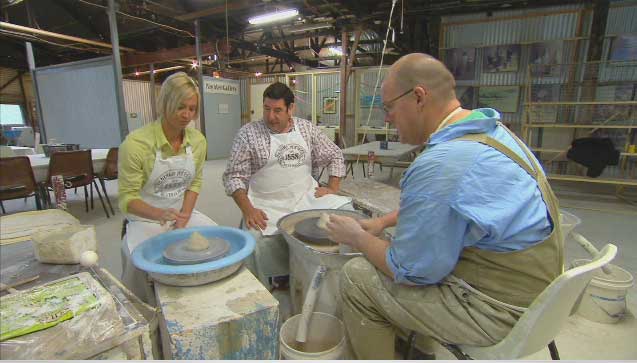Mathematical mind as flexible clay
Posted by: Gary Ernest Davis on: March 4, 2011
 Blair Miller (@millerblair) commented (March 3, 2011) on the blog post A challenge to mathematics teachers: can your class become a community of practice?
Blair Miller (@millerblair) commented (March 3, 2011) on the blog post A challenge to mathematics teachers: can your class become a community of practice?
He agreed with something I’d written on that post:
“It’s not hard helping students learn the techniques they need to analyze data. What is hard is getting them to be interested in the first place: it takes time and effort to draw out their interests.â€
He wrote:
I think you hit the nail squarely on the head here. The challenge in turning math class a collaborative workshop is not posing interesting questions, but getting students to develop their own interesting questions. Once a person knows the properties of clay (mouldable, dries hard, can be stained) it is easy to conceive of an end product that can be made of clay. It then becomes a process of developing the techniques to get from the clay to the end product.
I like this image a lot. Knowing about clay helps a person imagine an end product that can be made of clay.
Blair continues:
If we think of this comparison in a mathematics context, students must understand the “properties of mathematics†and perceive a connection between the end product (situation/case/problem) and a mathematical understanding of it.
I think this is difficult for students because in K-12 math is usually introduced as a method to solve a particular problem or situation rather than as a flexible material or tool similar to clay. In K-12, we (I am guilty of this) don’t help students look at end problems and make mathematical connections then learn or choose skills. We use/create problems that have one answer and particulary suited to one solution. No wonder those skills get associated with a limited situation.
I think the image of the flexibility of clay is particularly apt, if we think of “clay” as a metaphor for “mathematical mind”.
What is most powerful and most practically useful for students is to develop a flexible mathematical way of thinking. The stuff of their mathematical minds should be as flexible as soft clay. What happens in the teaching of mathematics so often is that we force students thinking into a rigid mold too rapidly by emphasizing limited solutions to limited problems.
Because of this approach, students are conditioned to be taught a specific approach to each problem they are presented. There is no development of the concept of what approaches might be available or why would one be more suitable than the other because they expect from experience to look for the one approach. Consequently, it isn’t surprising that students aren’t inclined to view situations in their world as being understandable through mathematical approaches. It takes a really interesting subject where the student has experience to then develop the questions and subsequent search for tools to answer those questions.
A potter starts each object with a lump of clay. The ability to turn this flexible material into a beautiful and useful polished object is the potter working with their mind and skill on the clay.
So let’s pursue the metaphor of mathematical mind as flexible clay. A student with such a soft pliable mind has to use their skill and experience to work on the substance of their mind to produce a beautiful and useful object.
This is what makes mind different from clay: the flexible mathematics student’s mind is both the clay and the potter!
The mathematical mind works, through experience, on its own substance, to create beauty and utility. As in all art, the process is one of problem solving.
Changing this will require a dramatic shift in the way math is taught from K-12 and in the way curriculum is developed. Curriculum constrains the process of exploration by limiting to a very specific set of problems and methods. For example, one of the learning objectives is “Solve one-step linear equations of the form ax = bâ€. It takes a creative teacher with a good understanding of mathematical relationships to interpret and translate that into an exploratory approach where the students seek out situations that encourage them to ask the questions that would be solved in this method.
My colleague and former student Dr. Lisa Warner studied the growth of flexible mathematical thinking in her doctoral thesis. In a nutshell, what seems to be a significant factor in enhancing a flexible mathematical mind is questioning from other students – from one’s peers.
It is not so much the curriculum that has to change, but the classroom practice.
Students need room to explore, to investigate, to talk, to discuss, to question and to respond.
Then the magic of the mathematical potter working on its own substance will produce beauty and utility.


March 5, 2011 at 7:56 am
These are excellent ideas but I still feel I need more concrete examples of how this would look.